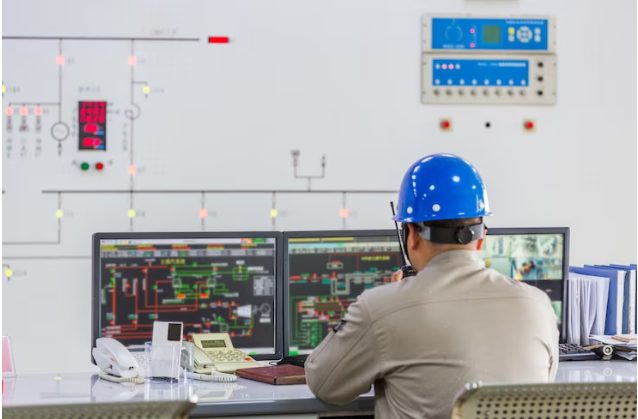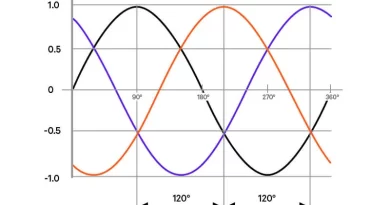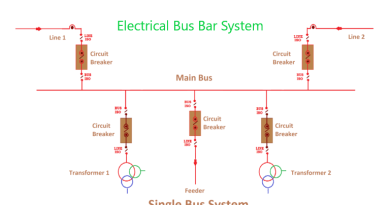Modern Power System Analysis – A Guide
Modern Power System Analysis
Outline
- Introduction
- What is power system analysis?
- Importance of power system analysis
- Overview of key concepts
- Load Flow Analysis
- What is load flow analysis?
- Methods of Load Flow Analysis
- Gauss-Seidel method
- Newton-Raphson method
- Fast decoupled load flow
- Applications of load flow analysis
- Fault Analysis
- What is fault analysis?
- Types of faults
- Line-to-ground faults
- Line-to-line faults
- Double line-to-ground faults
- Methods of fault analysis
- Symmetrical components
- Unsymmetrical fault analysis
- Stability Analysis
- Steady-state stability analysis
- Transient stability analysis
- Voltage stability analysis
- State Estimation
- What is state estimation?
- The weighted least squares method
- Kalman filtering
- Power System Security
- Preventive methods
- Corrective methods
- Conclusion
- Summary of key points
- Future trends in power system analysis
- FAQs
Modern Power System Analysis
The reliable and efficient operation of power systems is crucial for supplying electricity to homes, businesses, and industries. To achieve this, modern power systems require detailed analysis using advanced techniques and methods. Power system analysis provides invaluable insights into the behavior and performance of these complex systems. Let’s explore the key aspects of modern power system analysis.

Power system analysis refers to a set of computational methods power engineers use to study power systems under different operating conditions. The main objectives of power system analysis are to assess voltage levels, power flows, and equipment loading throughout the network. It aims to ensure the system can withstand sudden disturbances like short circuits or loss of components. Overall, power system analysis enhances the reliability and security of supply.
Power system analysis is vital for planning, designing, and operating power systems. For example, it is used to identify the best locations for new generation and transmission facilities. During emergencies, operators rely on analysis to take corrective actions to restore the system. With the growth of renewable energy, analysis helps integrate these resources into the grid. In short, system analysis is crucial for building smart, resilient power grids.
Some of the key techniques used in modern power system analysis are:
Load Flow Analysis
Load flow analysis calculates voltage magnitudes and angles at each bus for a given load condition. It provides data on active and reactive power flows in transmission lines. There are several methods for load flow analysis:
- The Gauss-Seidel method solves the power flow equations iteratively. It is simple to program but may fail to converge.
- The Newton-Raphson method provides faster convergence compared to Gauss-Seidel. However, it requires more computational resources.
- Fast decoupled load flow simplifies calculations by decoupling active and reactive power equations. It offers a good balance of speed and accuracy.
Load flow analysis has applications in planning, real-time monitoring, and contingency evaluation. For instance, it can identify congestion in transmission paths during peak load.
Fault Analysis
Fault analysis determines the impacts of short circuits or open conductors in the system. The common types of faults studied are:
- Line-to-ground faults – where a line makes contact with the ground.
- Line-to-line faults – where two lines make contact.
- Double line-to-ground faults – where two lines both contact the ground.
Key methods used are symmetrical components and unsymmetrical fault analysis. Fault analysis helps size circuit breakers and design protection systems for the network.
Stability Analysis
Stability analysis examines the ability of generators to remain in synchronism after a disturbance. The main types are:
- Steady-state stability analysis – studies small signal stability.
- Transient stability analysis – looks at stability after large disturbances over several seconds.
- Voltage stability analysis – examines stability following changes in load.
Stability analysis guides settings for generator controllers and identifies stability limits.
State Estimation
State estimation determines the operating status of the entire power system using available measurements. Key methods include:
- Weighted least squares – minimizes errors between estimated and measured values.
- Kalman filtering – uses a recursive algorithm to estimate states.
By providing a complete picture of the system condition, state estimation enhances monitoring and control capabilities.
Power System Security
Power system security focuses on maintaining a stable and balanced system at all times. Methods include:
- Preventive methods – optimize the system during planning and operation to handle contingencies.
- Corrective methods – take controlled actions like load shedding to restore the system after a failure.
Security analysis identifies threats and mitigation strategies to avoid blackouts.
In summary, modern power system analysis uses sophisticated computational techniques to ensure the reliability and resilience of these mission-critical networks. Load flow, fault, and stability analysis offer key performance insights. State estimation and security enhance real-time monitoring and emergency response capabilities. With the integration of renewable generation, power electronics, and smart grid technologies, power system analysis will continue to evolve and play a crucial role in building the grid of the future.
FAQs
Q: What is the main goal of power system analysis?
A: The main goal is to assess the operating condition and performance of the power system under both normal and disturbed conditions. This helps ensure the reliability and security of the electric supply.
Q: What information does load flow analysis provide?
A: Load flow analysis calculates the magnitude and phase angle of voltage at each bus along with the active and reactive power flows in transmission lines in the network.
Q: How does fault analysis help improve power system protection?
A: By simulating different types of faults, fault analysis helps determine the maximum short circuit currents. This data is used to select and set the proper ratings for protective devices like fuses and relays.
Q: What is steady state stability in power systems?
A: Steady-state stability refers to the ability of generators to stay in synchronism under small disturbances and keep power flows stable through transmission lines.
Q: What is the benefit of state estimation for power system operation?
A: State estimation provides a complete snapshot of the operating status of the power system, including voltage magnitudes and phase angles across the network. This enhances real-time monitoring and control capabilities.




